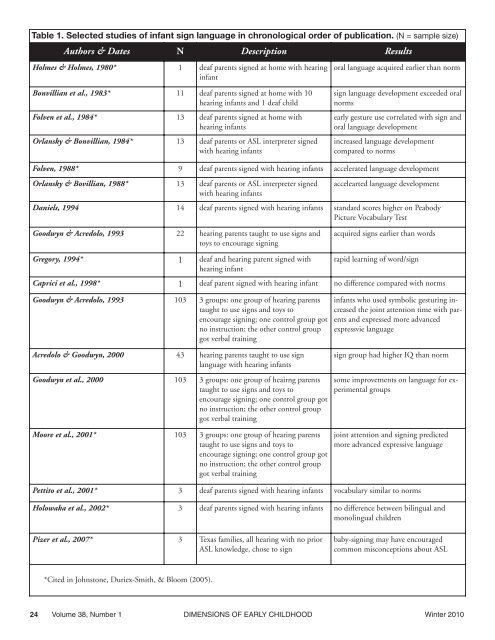90223 Dimensions Winter 10:Layout 1 - Southern Early Childhood ...
90223 Dimensions Winter 10:Layout 1 - Southern Early Childhood ...
90223 Dimensions Winter 10:Layout 1 - Southern Early Childhood ...
You also want an ePaper? Increase the reach of your titles
YUMPU automatically turns print PDFs into web optimized ePapers that Google loves.
Table 1. Selected studies of infant sign language in chronological order of publication. (N = sample size)<br />
Authors & Dates N Description Results<br />
Holmes & Holmes, 1980* 1 deaf parents signed at home with hearing<br />
infant<br />
oral language acquired earlier than norm<br />
Bonvillian et al., 1983* 11 deaf parents signed at home with <strong>10</strong><br />
hearing infants and 1 deaf child<br />
Folven et al., 1984* 13 deaf parents signed at home with<br />
hearing infants<br />
Orlansky & Bonvillian, 1984* 13 deaf parents or ASL interpreter signed<br />
with hearing infants<br />
sign language development exceeded oral<br />
norms<br />
early gesture use correlated with sign and<br />
oral language development<br />
increased language development<br />
compared to norms<br />
Folven, 1988* 9 deaf parents signed with hearing infants accelerated language development<br />
Orlansky & Bovillian, 1988* 13 deaf parents or ASL interpreter signed<br />
with hearing infants<br />
accelearted language development<br />
Daniels, 1994 14 deaf parents signed with hearing infants standard scores higher on Peabody<br />
Picture Vocabulary Test<br />
Goodwyn & Acredolo, 1993 22 hearing parents taught to use signs and<br />
toys to encourage signing<br />
acquired signs earlier than words<br />
Gregory, 1994* 1 deaf and hearing parent signed with<br />
hearing infant<br />
rapid learning of word/sign<br />
Caprici et al., 1998* 1 deaf parent signed with hearing infant no difference compared with norms<br />
Goodwyn & Acredolo, 1993 <strong>10</strong>3 3 groups: one group of hearing parents<br />
taught to use signs and toys to<br />
encourage signing; one control group got<br />
no instruction; the other control group<br />
got verbal training<br />
infants who used symbolic gesturing increased<br />
the joint attention time with parents<br />
and expressed more advanced<br />
expressvie language<br />
Acredolo & Goodwyn, 2000 43 hearing parents taught to use sign<br />
language with hearing infants<br />
sign group had higher IQ than norm<br />
Goodwyn et al., 2000 <strong>10</strong>3 3 groups: one group of heairng parents<br />
taught to use signs and toys to<br />
encourage signing; one control group got<br />
no instruction; the other control group<br />
got verbal training<br />
Moore et al., 2001* <strong>10</strong>3 3 groups: one group of hearing parents<br />
taught to use signs and toys to<br />
encourage signing; one control group got<br />
no instruction; the other control group<br />
got verbal training<br />
some improvements on language for experimental<br />
groups<br />
joint attention and signing predicted<br />
more advanced expressive language<br />
Pettito et al., 2001* 3 deaf parents signed with hearing infants vocabulary similar to norms<br />
Holowaka et al., 2002* 3 deaf parents signed with hearing infants no difference between bilingual and<br />
monolingual children<br />
Pizer et al., 2007* 3 Texas families, all hearing with no prior<br />
ASL knowledge, chose to sign<br />
baby-signing may have encouraged<br />
common misconceptions about ASL<br />
*Cited in Johnstone, Duriex-Smith, & Bloom (2005).<br />
24 Volume 38, Number 1 DIMENSIONS OF EARLY CHILDHOOD <strong>Winter</strong> 20<strong>10</strong>
















